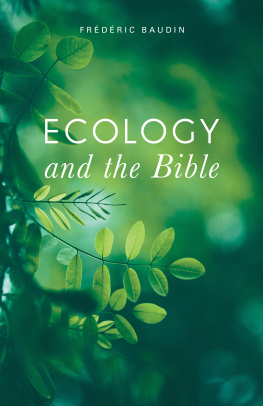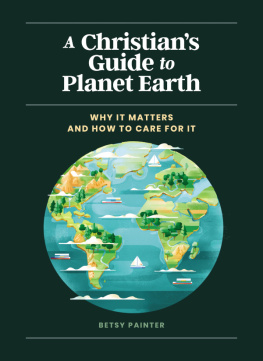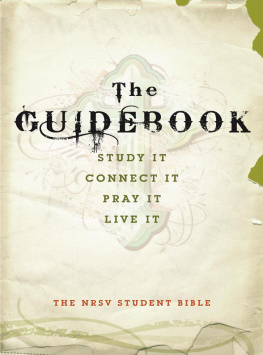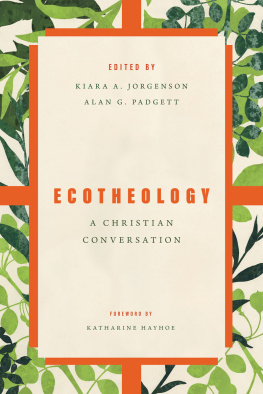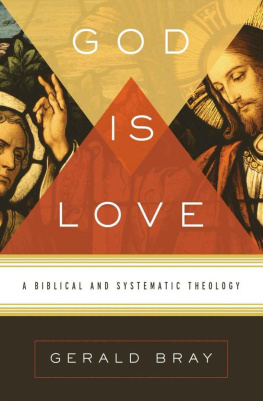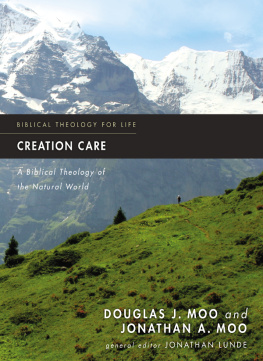Ecology and the Bible (ebook edition)
2020 Frdric Baudin
Translated by Damon DiMauro
Published by Hendrickson Publishers
an imprint of Hendrickson Publishing Group
Hendrickson Publishers, LLC
P. O. Box 3473
Peabody, Massachusetts 01961-3473
www.hendricksonpublishinggroup.com
ebook ISBN 978-1-68307-333-8
Originally published in French under the title: La Bible et lcologie
Copyright 2013 and 2020 by Frdric Baudin
Published by permission of Excelsis, 26450 Charols, France
Internet: www.XL6.com
All rights reserved. No part of this book may be reproduced or transmitted in any form or by any means, electronic or mechanical, including photocopying, recording, or by any information storage and retrieval system, without permission in writing from the publisher.
Unless otherwise noted, Scripture quotations contained herein are taken from the Holy Bible, New International Version, NIV. Copyright 1973, 1978, 1984, 2011 by Biblica, Inc. Used by permission of Zondervan. All rights reserved worldwide. www.zondervan.com The NIV and New International Version are trademarks registered in the United States Patent and Trademark Office by Biblica, Inc.
Scripture quotations marked RSV are taken from the Revised Standard Version of the Bible, copyright 1946, 1952, 1971 by the Division of Christian Education of the National Council of the Churches of Christ in the United States of America. Used by permission., All rights reserved.
Scripture quotations marked (ESV) are taken from the Holy Bible, English Standard Version (ESV), copyright 2001 by Crossway, a publishing ministry of Good News Publishers. Used by permission. All rights reserved.
Scripture quotations marked (NLT) are taken from the Holy Bible, New Living Translation, copyright 1996, 2004, 2015 by Tyndale House Foundation. Used by permission of Tyndale House Publishers, Inc., Carol Stream, Illinois 60188. All rights reserved.
Scripture quotations marked (NRSV) are taken from the New Revised Standard Version of the Bible, copyright 1989 by the Division of Christian Education of the National Council of the Churches of Christ in the United States of America, and are used by permission.
Scripture quotations marked CSB, are taken from the Christian Standard Bible, Copyright 1999, 2000, 2002, 2003, 2009, 2017 by Holman Bible Publishers. Used by permission. CSB is a federally registered trademark of Holman Bible Publishers.
Scripture quotations marked (TLB) are taken from The Living Bible copyright 1971. Used by permission of Tyndale House Publishers, a Division of Tyndale House Ministries, Carol Stream, Illinois 60188. All rights reserved.
Cover photo by Jasmina007 via Getty Images Plus
Due to technical issues, this ebook may not contain all of the images or diagrams in the original print edition of the work. In addition, adapting the print edition to the ebook format may require some other layout and feature changes to be made.
First ebook edition July 2020
INTRODUCTION
Lets imagine for a moment that a generous patron of the arts asks a couple who are among his close friends to take into their care a masterpieceperhaps one of Paul Czannes (18391906) post-Impressionist paintings of Sainte-Victoire, a mountain overlooking Aix-en-Provence in southern France. So great is its value that an insurer has appraised it at over one hundred million dollars. The husband and wife who have been appointed as caretakers now have the responsibility to safeguard this treasure for a time.
Grateful to be entrusted with this painting, they proudly display it in a prominent place in their home where family, friends, and visitors can admire its every detail. They appreciate Czannes mastery and his choice of vibrant colors, which he applied to the canvas with awe-inspiring grace. They marvel at his genius, especially his sensitivity to the variations of light over the landscape. They are astonished by his desire to return to this same motif, this mountain he painted so often, this Sainte-Victoire whose forms, beauty, balancelike an imprint of Godhe never ceased to explore, even as he sought to capture the bluish flowing hues of its movement toward the sky.
Over time, however, the once delighted caretakers begin to take the painting for granted. They gradually become indifferent to its beauty and even begin to neglect it. They no longer dust the canvas nor close the blinds against the midday suns harsh light. As a result, the artists brilliant colors fade and the landscape loses its sheen, becoming dismal and dull.
The caretakers then let their children begin to play on the couch situated just beneath the ornate frame. At first, they sternly admonish them to resist any temptation to damage the painting, warning of dire consequences should they dare even touch it. After a while, however, they barely say a word when their youngest makes a game of pressing jam-covered fingers against the canvas until it stretches and even cracks in certain places, including the mountains splendid summit. They do become quietly angry, though, when their eldest children begin to throw darts at the green trees and red roofs of the houses at the foot of the mountain, but they end up taking this damage in stride. At last, when their three children, emboldened by their inaction, cover what remains of Sainte-Victoire with dark smudges, they simply sigh and throw up their hands, and they ultimately turn the painting to the wall.
Trying to justify their lack of concern, the father says, We dont need to bother trying to repair the painting. After all, like all earthly things, it will eventually fade away. The mother then adds, I think this painting had become almost an object of worship. Too many of us had become overly engrossed in the work itself to the point that the artist himself was no longer fully appreciated. With this, they conclude that they had done well to hide it.
Imagine now that the original owner of the painting returns to reclaim Czannes masterpiece. What should be his reaction when he sees what has become of it? His anger, his righteous indignation against the negligent caretakers, would be understandable. He thinks about taking them to court over the cost of the ruined painting, but then another generous lover of the arts offers to restore the entire painting at his own cost. Thanks to this providential mediator, the owner no longer needs to prosecute the couple he had entrusted with the safekeeping of the grand masters work. He even allows it to remain with them, since they seem to sincerely regret their negligence. They promise to watch over the painting until the owner is ready to take it backthough he does wonder if he can trust them after this.
Although the anecdote here might seem far-fetched, it should be obvious that we are really talking about Gods creationand how we have neglected his masterpiece, this earth. In our capacity as free and responsible human beings, we have been mandated by the Creator to care for his creation. Like our story with a new art lover willing to restore the painting, however, perhaps it is not too late to fulfill our original mandate.
Since Jesusour generous benefactorhas indeed redeemed our world (although we are still awaiting the final fulfillment from him), there is still time for us to be witnesses of the firstfruits of this restoration and hope by taking care of our planet in these latter days with faith and with lovetoward both the Creator and his creation.
1. THE STEWARDSHIP MANDATE AND ITS IMPLICATIONS
God blessed them and said to them, Be fruitful and increase in number; fill the earth and subdue it. Rule over the fish in the sea and the birds in the sky and over every living creature that moves on the ground. (Gen. 1:28)

